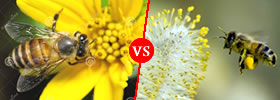Difference between Pine Wood and Rubber Wood
Key difference: Pines are considered to be a softwood, light weight and less expensive. Due to its light weight, pine is quite popular for bedroom furniture, such as wardrobes, beds, as it is much easier to move this furniture around. Rubberwood is essentially the wood that comes from the rubber tree, the Pará rubber tree to be specific. The Pará rubber tree is scientifically known as Hevea brasiliensis. As the wood of a rubber tree, one would expect it to be soft and springy like, well, rubber. However, rubber wood is essentially a hardwood.
 Wood is mainly classified into two categories: hardwood and softwood. Many people consider that hardwood is named such because it is harder and denser than softwood. This is true often enough, but not all the time. Take for example the balsa wood, which is soft, light and less dense than most other woods, but is classified as a hardwood. The classification of the wood is not actually done on the basis of weight or density; rather it is done on the basis of plant reproduction.
Wood is mainly classified into two categories: hardwood and softwood. Many people consider that hardwood is named such because it is harder and denser than softwood. This is true often enough, but not all the time. Take for example the balsa wood, which is soft, light and less dense than most other woods, but is classified as a hardwood. The classification of the wood is not actually done on the basis of weight or density; rather it is done on the basis of plant reproduction.
Pines are considered to be a softwood, light weight and less expensive. Due to its light weight, pine is quite popular for bedroom furniture, such as wardrobes, beds, as it is much easier to move this furniture around.
Softwoods generally are wood from a gymnosperm tree. A gymnosperm is a type of tree that has seed that have no covering and tend to fall to the ground. Gymnosperms reproduce by forming cones which emit pollen to be spread by the wind to other trees. Most softwood tends to come from conifers like pines, firs and spruces. Conifers are also commonly called evergreens because their leaves tend to stay green and do not fall to the ground in cycles. Some famous softwood trees are pine, redwood, fir, cedar, and larch.
Pine is also known to be stiff and sturdy and resistant to shock, but it does wear down over time, especially when exposed to heavy use. It has a more rustic look and tends to show off natural characteristics like knots and other flaws. Hence, it is much better for an antique look. However, pine will always be smooth to touch.
Pine is also more porous; hence it absorbs paints well. However, pine does not absorb stains evenly, so a natural look or painted look is a better option for pine.
Difference varieties of pine, include yellow pine, which may have a yellow or red color, as well as a fairly deep grain; white pine tends to be pale with a barely visible grain; and red pine, which is the darkest of the pines and has the heaviest grain.
 Rubberwood is essentially the wood that comes from the rubber tree, the Pará rubber tree to be specific. The Pará rubber tree is scientifically known as Hevea brasiliensis. As the wood of a rubber tree, one would expect it to be soft and springy like, well, rubber. However, rubber wood is essentially a hardwood.
Rubberwood is essentially the wood that comes from the rubber tree, the Pará rubber tree to be specific. The Pará rubber tree is scientifically known as Hevea brasiliensis. As the wood of a rubber tree, one would expect it to be soft and springy like, well, rubber. However, rubber wood is essentially a hardwood.
Basically, hardwood is the wood that comes from an angiosperm tree. This is a type of tree that has seeds that are enclosed, be it in pods, a shell, a covering or in a fruit. For example, apples or nuts and seeds like acorns and walnuts. These types of seeds allow birds and insects to be attracted to the flowers of the tree and be able to carry the pollen to other trees. This is also the reason why hardwood trees are not often bunched together but are spaced apart and often have other trees in-between them.
Most hardwood trees are also deciduous is nature. A deciduous tree is a tree that loses its leaves annually. Hardwood trees are also slower to grow, taking their own time. Due to this, most hardwood is dense. This is also the reason that hardwood is expensive, as it takes longer to grow. Some famous hardwoods include maple, balsa, oak, elm, mahogany, and sycamore.
The Pará rubber tree is essentially grown in plantations for the latex it produces, which is then harvested and used in the production of commercial rubber. However, after 25 – 30 years, the production of latex in the tree becomes very low; hence the tree is often cut down and replaced with another, which would be more financially viable.
Previously, the felled rubber tree would be burned, as there would be no further use for it. However, in lieu of growing environmentalism, the wood from the felled rubber tree is now recycled and used in various applications. The most common applications of the rubber wood include furniture, toys and kitchen accessories. Like all hardwoods, rubber wood comes in varying degrees of quality.
The advantage of rubber wood is that it s a dense grain that is easily controlled in the kiln drying process. This makes is easily manageable in the kitchen. However, the rubber wood is not suitable for outdoor usage. Furthermore, rubber wood is touted over other types of wood because as it is essentially a recycled wood, it is more eco-friendly.
Image Courtesy: made-in-china.com, europack.co.in









Add new comment